Virginia is home to an impressive array of rocks, minerals, gems, and crystals. From the sparkling quartz in the Blue Ridge Mountains to the deep coal deposits of the Appalachian Plateau, our state is a geologist’s dream!
Have you ever strolled along the banks of the James River and stumbled upon a gleaming piece of mica or pyrite? Or ventured into the Shenandoah Valley only to discover gems that glisten under the sun?
Virginia’s varied landscapes provide ample opportunities for anyone, whether you’re a curious student, a hobby collector, or just someone who admires the beauty beneath our feet.
No matter where you are in our beautiful state— from the coastal plains to the western highlands— there’s a story written in stone waiting to be discovered. In this article, we’ll get to know some of the most common and even rare finds our state is known for.
A List of The Common Rocks, Stones, and Minerals Found in Virginia
Our state may be endowed with so many natural wonders, but it doesn’t mean it’s a piece of cake to find them. More often than not, you will need the right guidance to point you to the right places where you can look for these different types of rocks in Virginia. If you want to find them, check out these guides that we created:
Virginia Rock and Gem
Let’s first get to know Virginia’s flagship natural wonders.
| Virginia State Rock | Nelsonite |
| Virginia State Gem | Amazonite (unofficial) |
It’s also important to study and comply with our state’s local collecting guidelines during our exploration here. To know more about this, visit the official website of the Virginia Department of Mines, Minerals, and Energy (DMME) which regulates rockhounding here.
Always Confirm Access and Collection Rules!
Before heading out to any of the locations on our list you need to confirm access requirements and collection rules for both public and private locations directly with the location. We haven’t personally verified every location and the access requirements and collection rules often change without notice.
Many of the locations we mention will not allow collecting but are still great places for those who love to find beautiful rocks and minerals in the wild without keeping them. We also can’t guarantee you will find anything in these locations since they are constantly changing.
Always get updated information directly from the source ahead of time to ensure responsible rockhounding. If you want even more current options it’s always a good idea to contact local rock and mineral clubs and groups
Galena
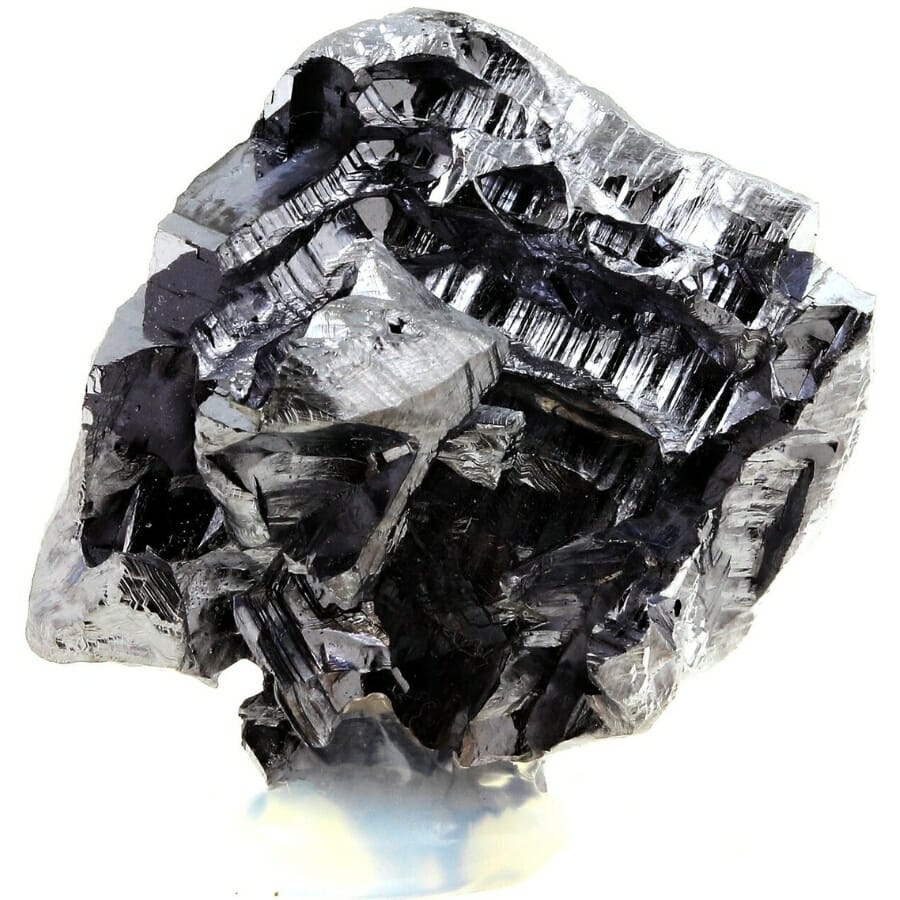
You’ve probably already seen a galena before since it’s quite common. Mostly made of lead, it has a bright silver color and shiny, metallic appearance. Sometimes it forms shiny cubes, and other times you might see it in more complex shapes.
Galena usually forms deep inside the Earth, where hot fluids bubble around rocks. Over time, these fluids turn into galena.
This mineral is valued not only for its interesting looks but also for making lead, which we use in batteries and shielding against radiation. Sometimes, galena even has silver in it, which makes it extra special.
Where you can find Galena in Virginia
You can find galena in our state by exploring different spots, such as:
- Between Shiloh Mountain and Appleberry Mountain in Albemarle County
- Betty Baker Mine in Hillsville, Carroll County
- Area mines in Faber in Nelson County
Marble
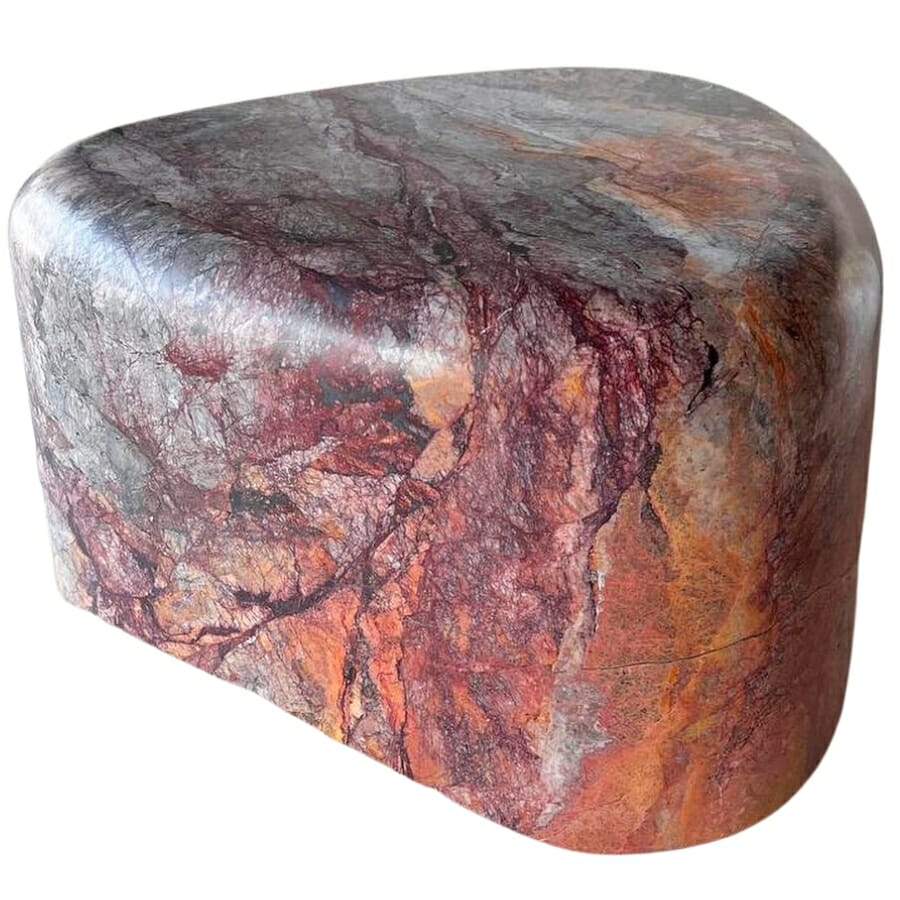
Marble is a beautiful and elegant rock that many people love! But did you know it starts its life as something completely different?
It begins as limestone, a rock that’s found in many places, including Virginia. When it gets heated and squeezed, it transforms into marble. This magical transformation gives marble its swirls of colors and sparkly crystals.
With its ethereal beauty and usability, it’s no surprise that marble’s value is soaring! It has been used for thousands of years for art, buildings, and more. Artists value it because it’s soft enough to carve but strong enough to last. You might have seen marble statues or fancy countertops in kitchens and bathrooms.
Where you can find Marble in Virginia
If you want to uncover marble here, you can explore through the marble quarry at Highcamp Road in Loudoun County.
Nelsonite
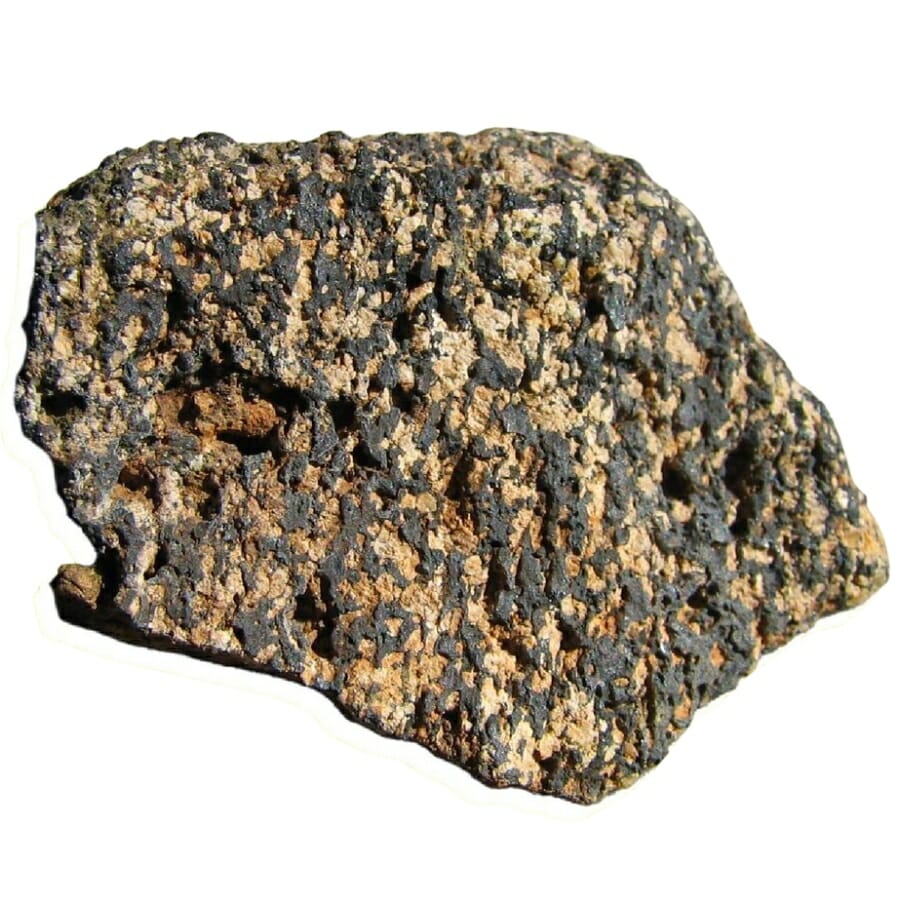
Nelsonite is an exciting rock that has a special connection to our state— it’s Virginia’s state rock! Named after Nelson County, it’s a rock made up of two main minerals: apatite and ilmenite.
Picture bubbling, hot magma. As it cools down, its minerals come together and create nelsonite.
The minerals in this rock are super useful. Apatite (which we will discuss more of below) is used in fertilizer to help plants grow strong and healthy, while ilmenite is used to make things like paint and even some metals.
Where you can find Nelsonite in Virginia
True to its name, nelsonite can be found in Nelson County. It also naturally occurs in Roseland and Amherst Counties.
Feldspar
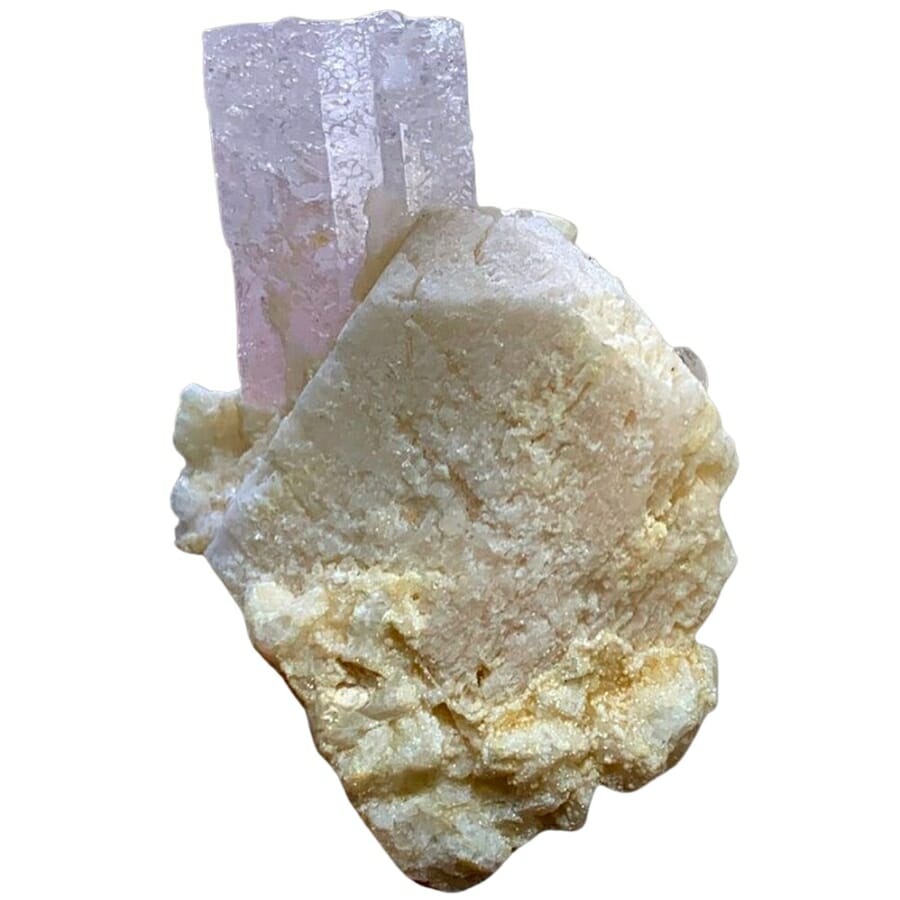
Feldspar is like Mr. Popular of the rock world because it’s found in so many rocks! It comes in a variety of colors: pink, white, or even sparkly.
When magma cools down, feldspar crystals start to grow. Sometimes, it can even form from super-hot water that changes other rocks.
While it’s common, feldspar is still very valuable. Have you ever used pottery or looked through a glass window? If so, then you’ve used something made with feldspar since it’s an essential ingredient in ceramics and glass.
This rock even adds sparkle to toothpaste products.
Where you can find Feldspar in Virginia
You can visit the following places where feldspar is found:
- Burks Creek in Carroll County
- O.W. Harris Mica Mine in Goochland County
- Area mines and pegmatites of Peaks of Otter in Bedford and Botetourt Counties
Pyromorphite
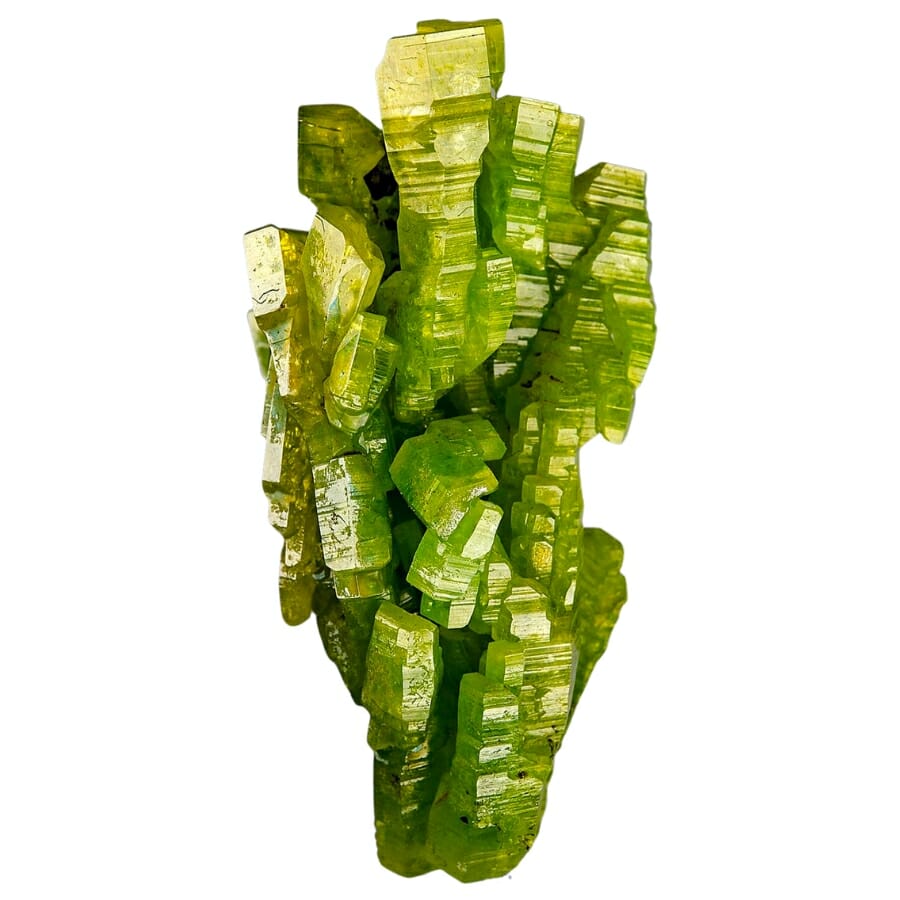
Pyromorphite is a mineral with a name that sounds like it’s straight out of a superhero comic, and it’s just as cool! It can be green, yellow, orange, or even brown and has bright, shiny crystals that look like they’re glowing.
When galena reacts with certain chemicals, pyromorphite crystals start to grow.
Collectors love this mineral for its stunning colors and unique crystal shapes. Sometimes, its crystals look like barrels or hexagons, which is simply amazing to see! Scientists also study it to understand more about our planet’s geology.
Where you can find Pyromorphite in Virginia
You can find pyromorphite in the area mines of Faber in Nelson County.
Magnetite
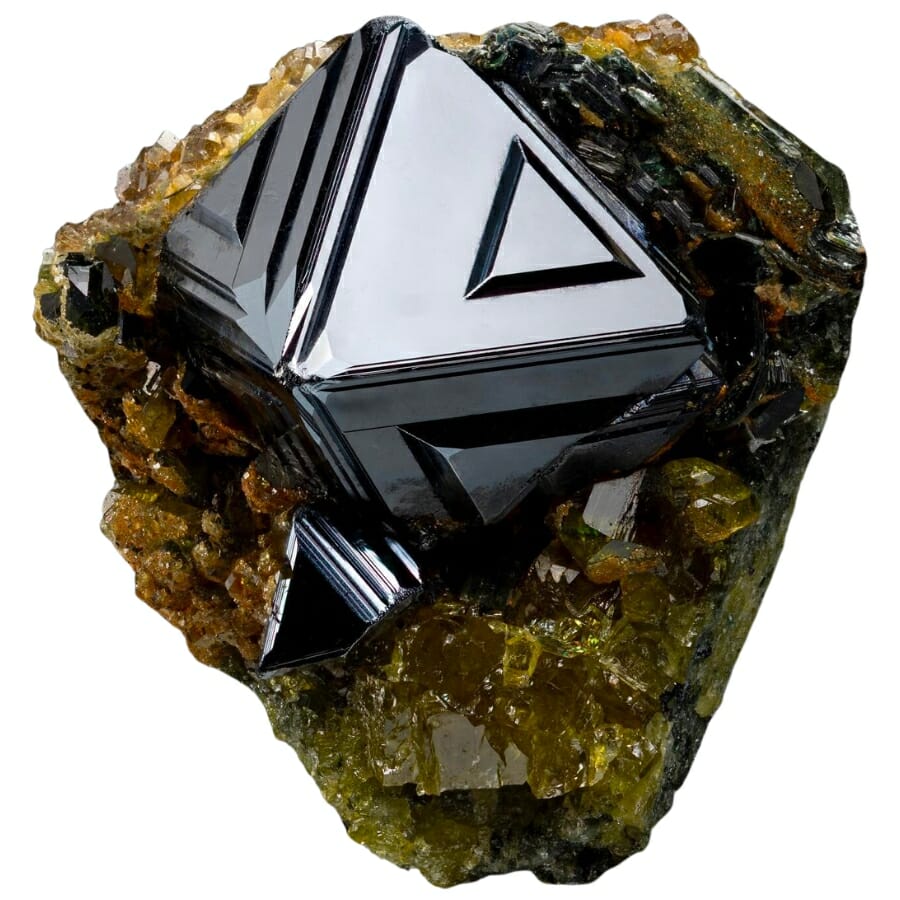
True to its name, magnetite is a mineral that attracts metal objects, just like a magnet.
Besides being magnetic, which is already pretty exciting, magnetite is also used in lots of everyday things. People mine it to make iron and steel, so it might be in your bike, car, or even your school’s building. That’s why magnetite’s value is just as magnetizing!
Luckily, magnetite is part of the rich tapestry of rocks and minerals here in Virginia.
Where you can find Magnetite in Virginia
We recommend visiting the following locations to find magnetite:
- King-Ramsey Quarry in Franklin County
- Old Sulphur Mine in Louisa County
- Hairston Mine in Patrick County
Hornblende
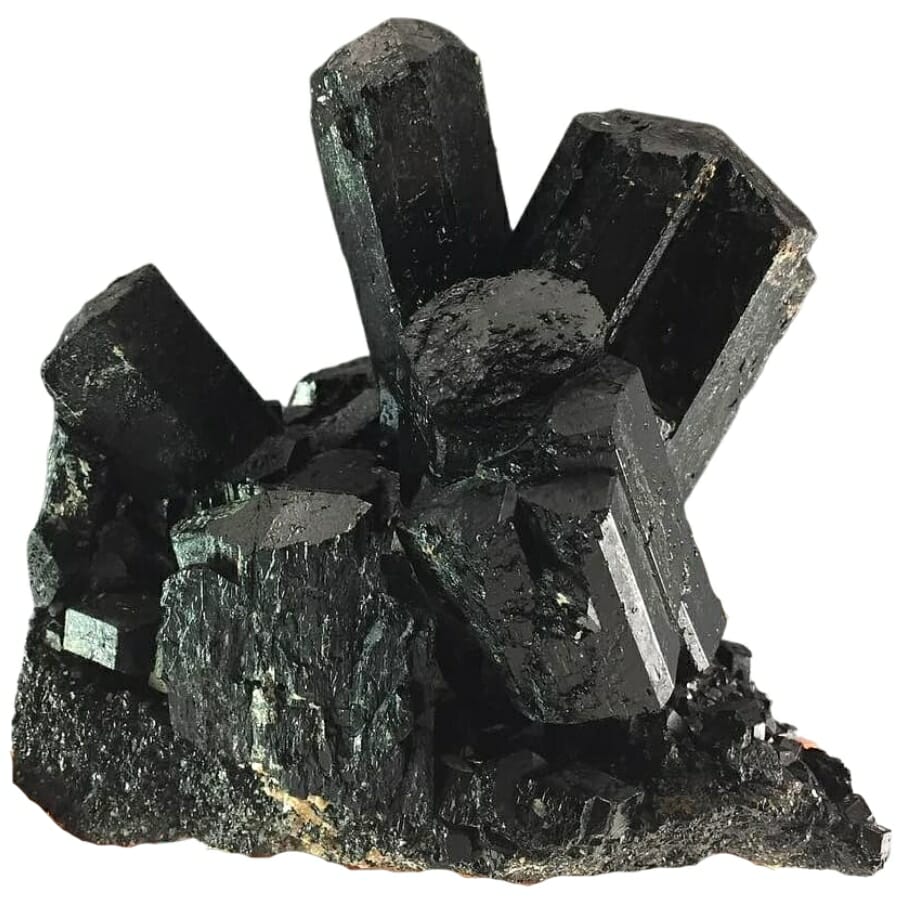
Hornblende is part of a group of minerals that often show up in different types of rocks, especially in igneous rocks like granite. It’s usually dark green to black in color, sometimes with a little shine.
Geologists love this mineral because it tells them about the conditions deep inside the Earth where the magma was formed.
Hornblende’s not just for studying, though. It also adds strength to rocks, making them more resistant to weathering. This can be important for things like building materials for the walls of buildings or even roads.
Fortunately, this mineral is found in many rocks throughout our beautiful state. From the Blue Ridge Mountains to other rocky areas, hornblende is part of Virginia’s geological story.
Where you can find Hornblende in Virginia
We highly recommend exploring the Pipers Gap in Carroll County to find hornblende.
The Gemstones Found In Virginia
Now, let’s jump into the sparkly, mesmerizing, and stunning gemstones that you can stumble upon during your rockhounding adventure in Virginia.
Well, you’d be too lucky to just “stumble upon” these finds. More often than not, you’ll need a great guide to spot them, and we created just that for you:
Amazonite
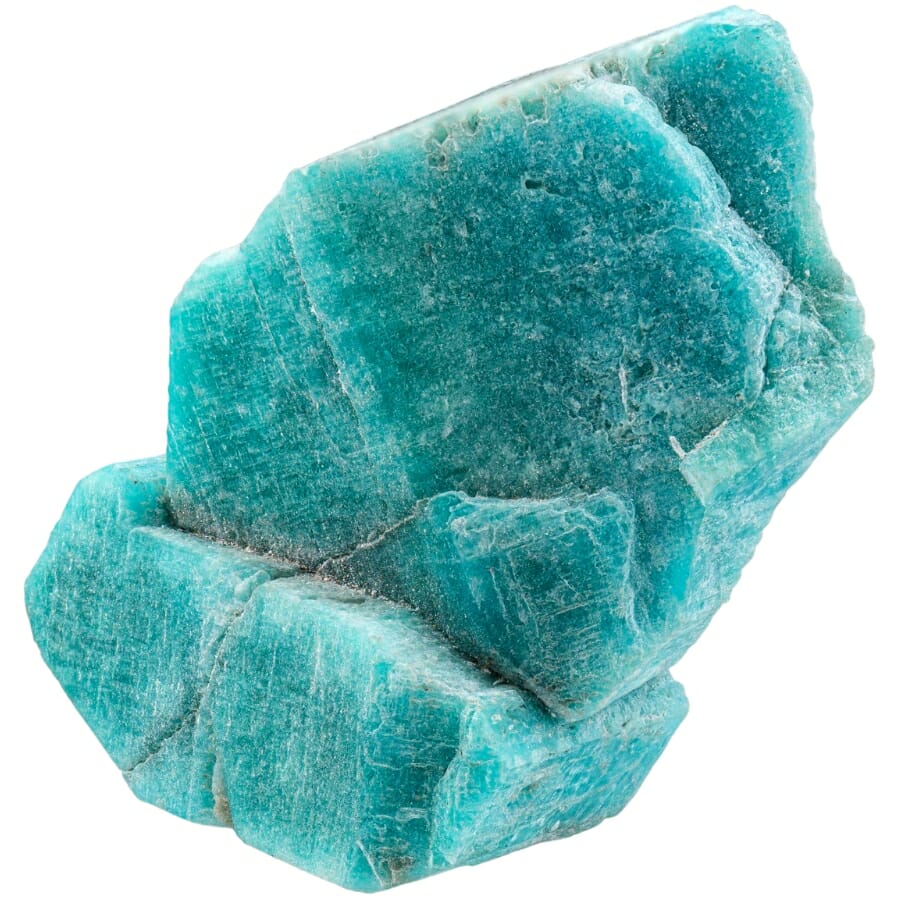
With its mesmerizing green-blue color, amazonite is like a gemstone daydream! Imagine a piece of the Amazon rainforest captured in a sparkling stone, and you’ve got amazonite.
This gem forms in unique rocks called pegmatites. Imagine a big, bubbling stew of molten rock and hot water deep underground. As it cools down, it starts to crystallize.
How valuable is amazonite? It’s valued for its breathtaking color which makes it a popular gem for jewelry and decorative pieces. Some even believe it has a soothing energy that can calm your mind.
Not only does Virginia have amazonite, this gem is actually our unofficial state gemstone. Specimens found here often have their own unique green color that sets them apart from amazonite found elsewhere.
Where you can find Amazonite in Virginia
Planning on exploring our state for amazonite? Make sure to include these places in your itinerary:
- Amelia Court House in Amelia County
- Young Mine in Bedford County
- Herbb No. 2 Mine in Powhatan County
Garnet
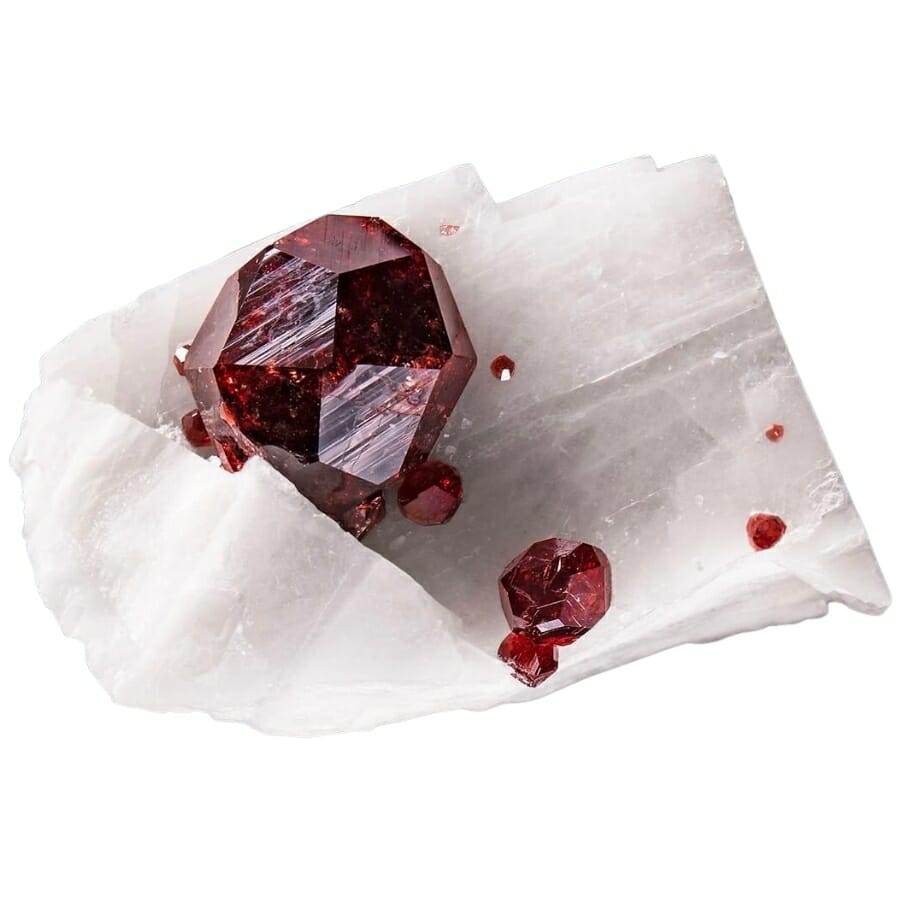
Most people think of a rich red when they hear “garnet,” but this gemstone can actually be pink, green, yellow, orange, or even colorless.
Picture your favorite clay toy, now squeeze and heat it until it becomes something new. That’s how garnets form, crystallizing under those extreme conditions. They’re usually found in metamorphic rocks, but they also show up in igneous rocks.
Garnet’s value is tied to its stunning appearance and properties. It has been used for years in jewelry, symbolizing love, passion, and friendship. And since it’s hard and durable, this gem isn’t just for wearing. It’s also used in industry for things like sandpaper and waterjet cutting.
In Virginia, you can find different types of garnets, like almandine and spessartine. Some might be deep red, while others have a more orangey or brownish hue.
Where you can find Garnet in Virginia
Garnet is found in quite a handful of places in our state, including:
- Hottinger Mine in Bedford County
- Saunders No. 2 Mine in Hanover County
- Mica Mines in Charlotte County
Calcite
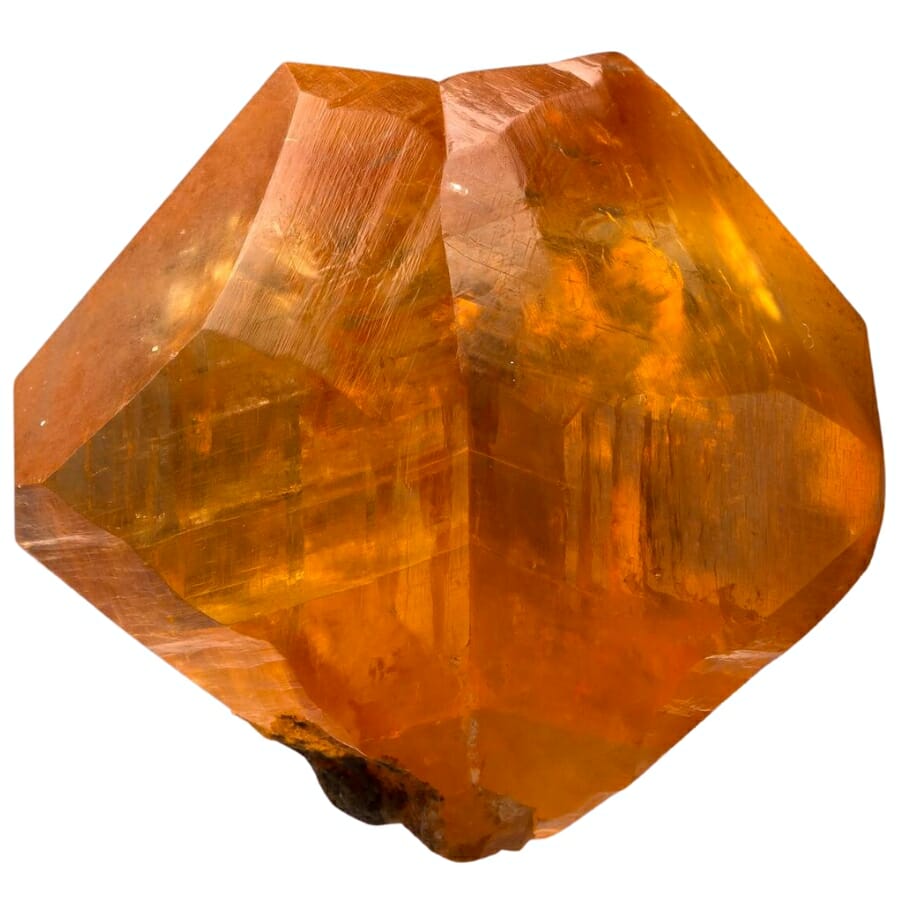
Like garnet, calcite can be found in so many colors and shapes. From clear to yellow, pink, green, or even blue, it wears many faces, and each one is amazing!
Calcite forms in various environments, like caves, hot springs, or even deep in the ocean. Imagine dripping water in a cave, slowly building up into a sparkling formation. It’s this gem in action!
Why do people value calcite? It’s not just a pretty face. It’s used in lots of everyday things, like toothpaste and antacids. It’s also a major part of limestone, which is used in buildings and roads.
Calcite is also a favorite among collectors. Its many shapes and colors make it a gem for anyone who loves rocks and minerals. Some believe it has special energies that can help with learning and memory. It’s like having a sparkly study buddy!
Where you can find Calcite in Virginia
You can find calcite in many sites of our state like:
- Between Shiloh Mountain and Appleberry Mountain in Albemarle County
- Craigsville area in Augusta County
- James River Hydrate & Supply Company Quarry in Botetourt County
Amethyst
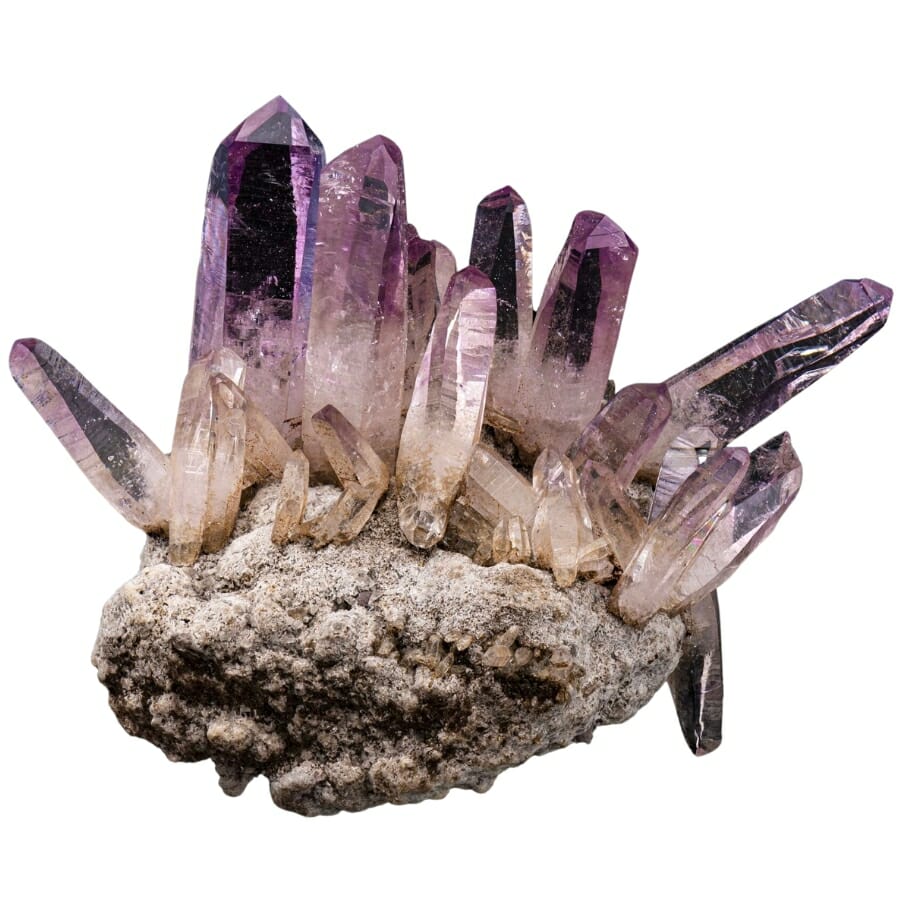
With its dazzling shades of purple, amethyst is like a royal gem! Imagine the colors of a sunset mixed with the sparkle of a starry night, and you’ve got this gem.
Amethyst’s purple hue ranges from light lilac to deep, rich violet. Tiny bits of iron in the crystal and some natural radiation combine to create this masterpiece. Nature sure knows how to paint with minerals!
Amethyst is highly valued and loved for thousands of years. Besides being gorgeous, ancient cultures believed it could prevent drunkenness (quick trivia: its name actually means “not intoxicated” in Greek!). It’s widely used in jewelry and even in art and decorations.
Where you can find Amethyst in Virginia
To find beautiful amethyst specimens here, pay a visit to these places:
- A.W. Donald Plantation in Charlotte County
- Schaar Farm in Amherst County
- Lacey Rush property in Campbell County
Apatite
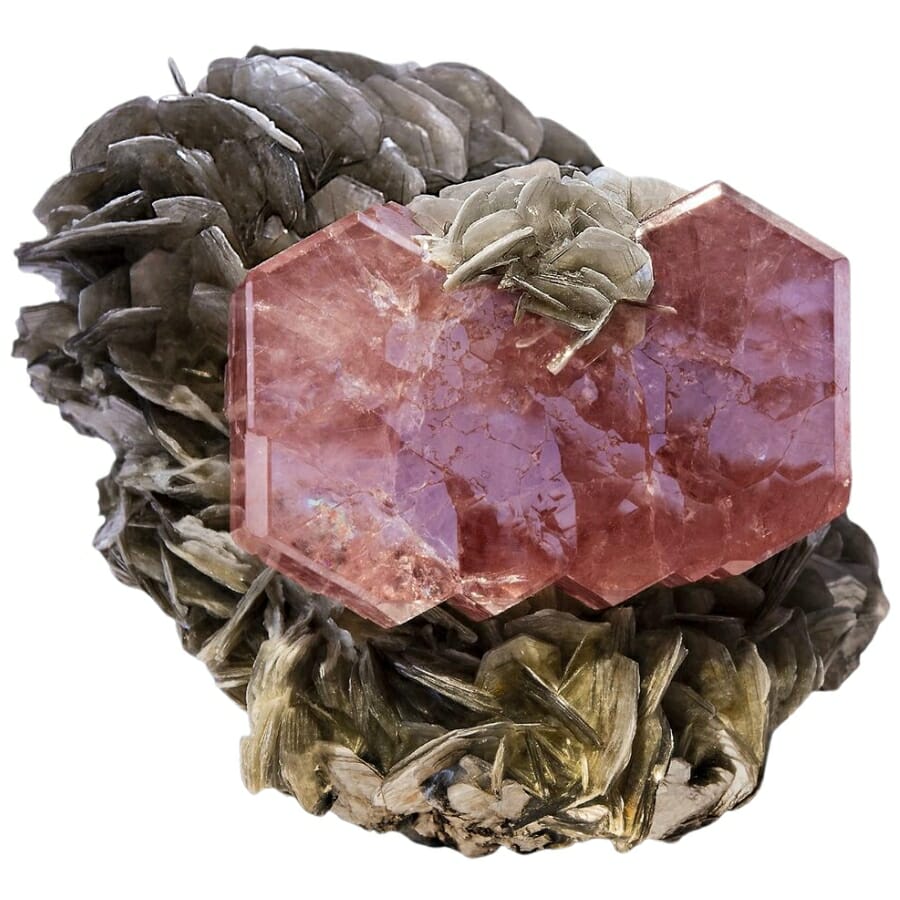
Apatite’s name comes from a Greek word that means “to deceive,” but it’s not that at all! This wonderful gem comes in a rainbow of colors, and it’s more common than you might think.
This gem can be blue, green, yellow, or even colorless. Sometimes, it’s even mistaken for other gems because of its wide color range. It grows in many different types of rocks, likes to mix with other minerals, and can be found in clusters of beautiful crystals.
Aside from being a stunning gem, apatite is a key ingredient in something you use every day: your teeth! It forms the hard parts of our teeth and bones.
It’s also important for farmers. Crushed apatite rocks are used as a source of phosphorus in fertilizers, so it helps plants grow strong and healthy.
Where you can find Apatite in Virginia
If you want to find apatite here, consider visiting these locations:
- Gladehill School in Franklin County
- Roseland area in Nelson County
- Front Royal area in Warren County
Rhodonite
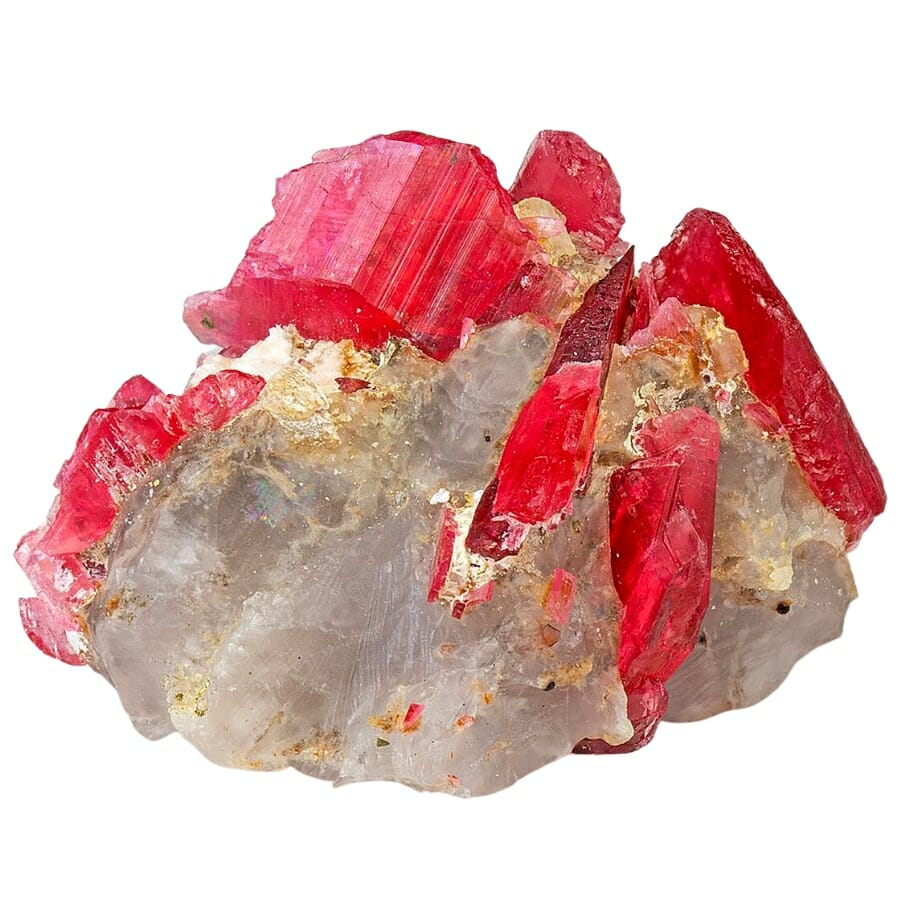
Rhodonite is mostly pink, with dark red, black, or brown patterns swirling through it. Just picture a sunrise captured in stone, and you’re close to imagining its beauty.
This fantastic gemstone comes to life when magma cools down and forms into rock. Its pink color comes from manganese. Over time, other minerals join in, creating their fascinating patterns.
The value of rhodonite is mostly based on its looks and uses. Jewelers carve it into beads, pendants, and other pieces that look great with just about anything. Some people also think it helps with healing and forgiveness.
Aside from this, it’s used for making things like knobs, vases, and other decorative items. It’s like a touch of nature’s beauty in everyday things!
Where you can find Rhodonite in Virginia
You can find rhodonite in Fluvanna County, specifically in the Central Plains area and the Kidd’s Store area.
Topaz
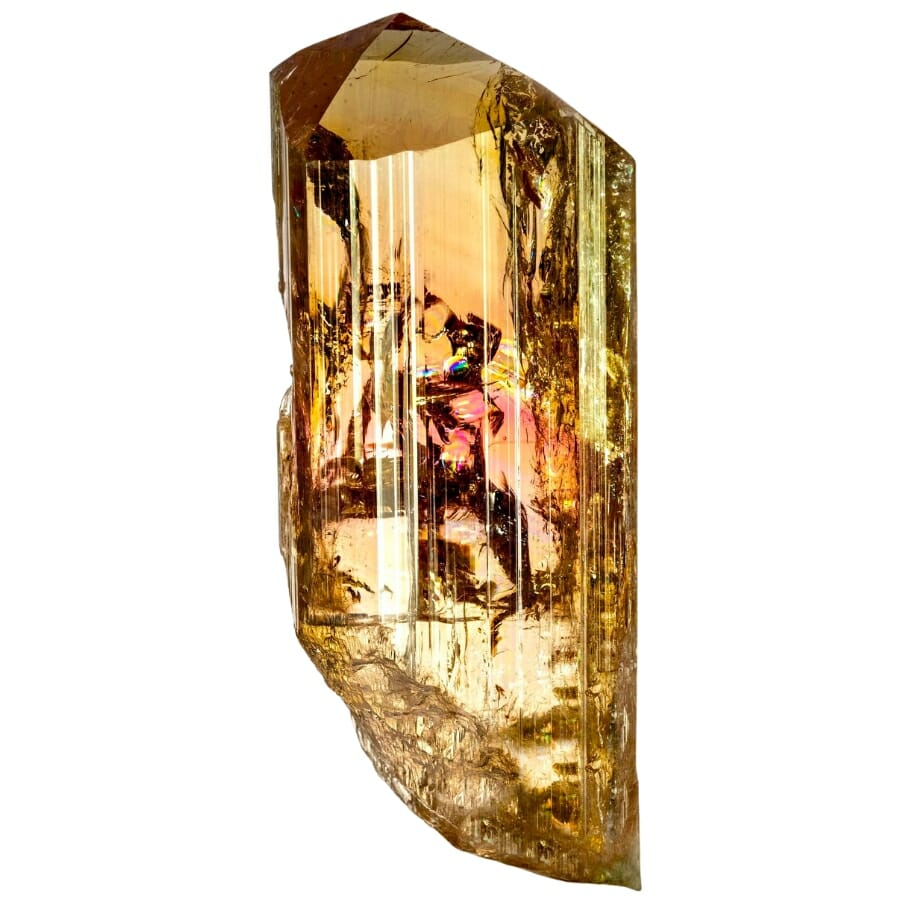
Topaz is known for its dazzling colors and crystal-clear beauty. It can be found in many shades: blue and green, yellow, pink, or even completely clear. It’s found in rocks that are formed from cooling magma.
Topaz is loved for one thing— it’s stunning to look at! Jewelers adore it because it sparkles and shines in the light. It’s like wearing a piece of sunlight or a drop of the sea. Some people even believe it has special powers, like bringing joy and success.
Best of all, topaz is considered a hard gemstone, standing at 8 on the Mohs scale of hardness. Imagine a gem that can keep its sparkle and shine through the everyday bumps and bangs, that’s topaz!
Where you can find Topaz in Virginia
Find topaz by exploring and searching through these spots:
- Amelia Count House in Amelia County
- Willis Mountain in Buckingham County
- Leigh Mountain in Prince Edward County
The Crystals Found In Virginia
If the rocks, minerals, and gems of Virginia amazed you, wait till you read about and see the photos of its astounding crystals. If you’re up and ready to go on your search for them, our complete guide to finding them will surely come in handy:
Quartz
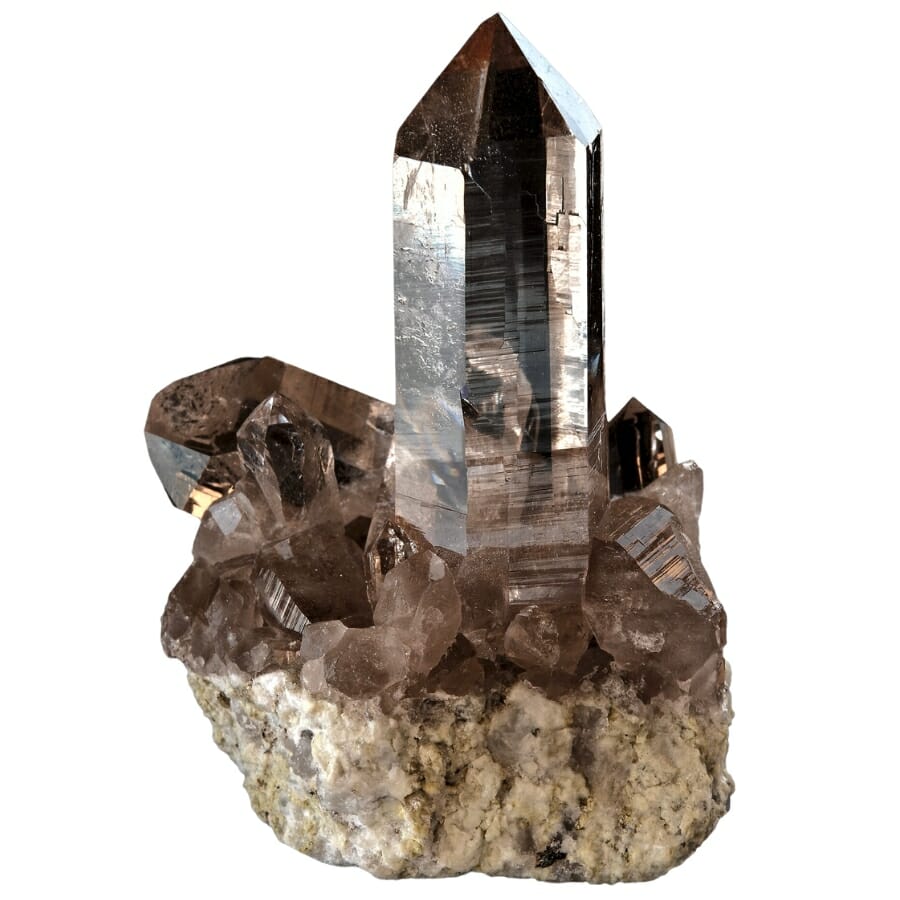
Quartz is one of the most common crystals, but there’s nothing ordinary about it. It can be clear as a mountain stream or colorful like a rainbow.
It’s formed in many different ways. Sometimes, it grows slowly in cracks in rocks as hot water passes through, leaving behind tiny quartz crystals. Other times, it forms from cooling magma.
The value of quartz isn’t just because it’s beautiful; it’s useful too! It’s used in watches, radios, and even computer chips.
Luckily, our state is endowed with different types of quartz. From the Blue Ridge Mountains to the Piedmont area, quartz is a part of Virginia’s landscape.
Where you can find Quartz in Virginia
We suggest searching through these sites if you want to find quartz:
- Hillsboro Quarry in Albemarle County
- George R. Smith far in Prince Edward County
- Spruce Run in Giles County
Epidote
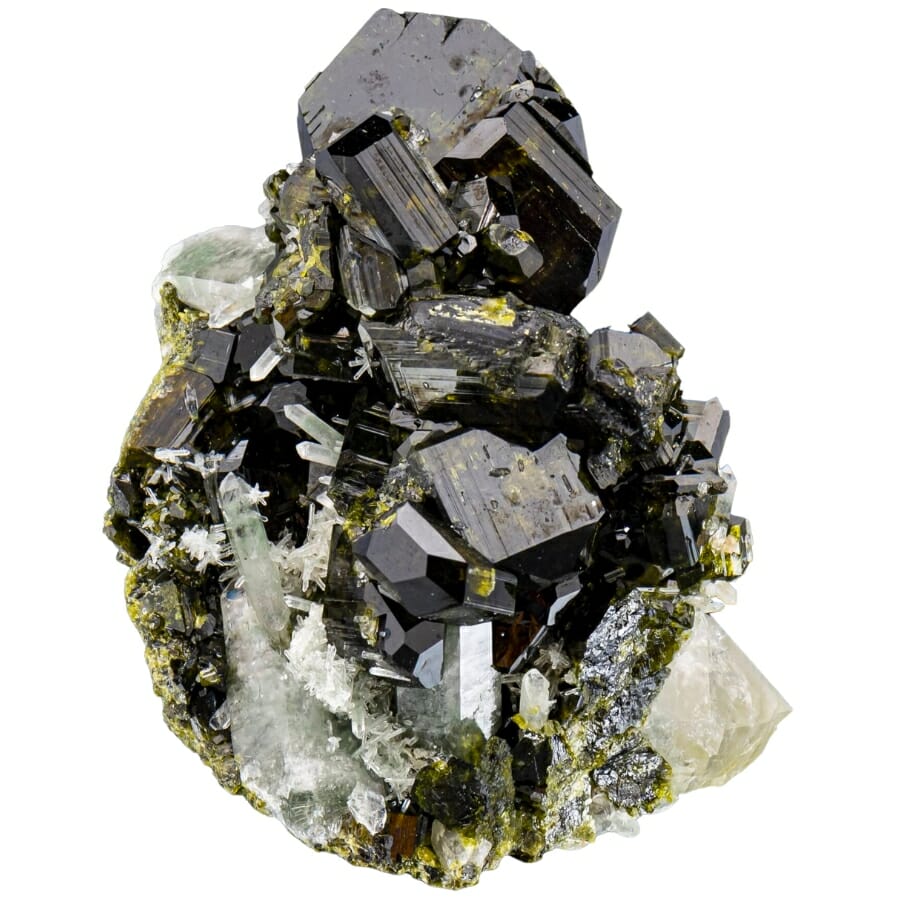
Epidote got this neat green color that can range from bright to dark. Sometimes, it’s even multicolored!
But it’s not just a pretty face. It’s actually used by scientists to understand the history and conditions of the rocks it’s found in. It’s also loved for jewelry and decoration because its green color makes a great conversation piece.
This crystal has been spotted in different areas within our state, with specimens varying in color and shape. Sometimes, it grows with other minerals, forming a complex crystal dance. You might find epidote with quartz or other crystals.
Epidote also has a talent for showing different shades of green depending on how you look at it. This property is called pleochroism, and it makes this crystal one-of-a-kind.
Where you can find Epidote in Virginia
To find epidote, we recommend you visit and search through the following areas:
- Early property in Hillsville area, Carroll County
- Fontaine area in Henry County
- Ida area in Page County
Unakite
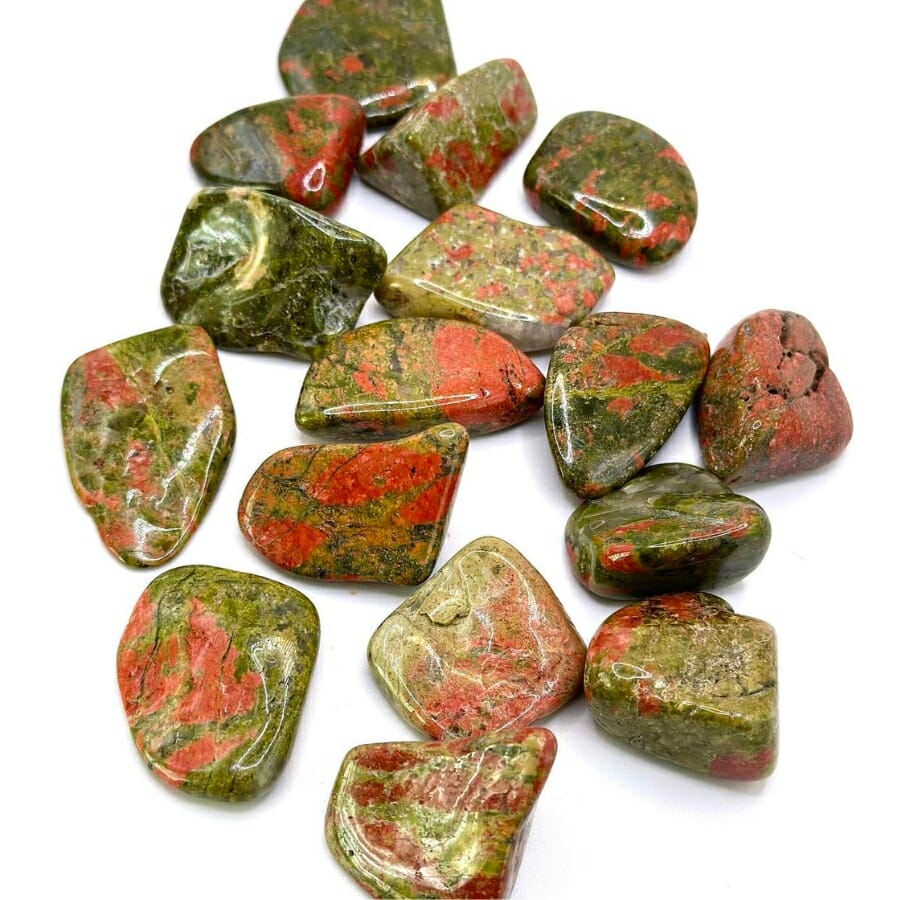
Unakite is a unique mixture of two awesome minerals: green epidote and pink orthoclase feldspar. When they come together, they create a cool and colorful combination that can make anyone’s eyes sparkle.
This crystal forms when rocks go through changes with heat and pressure, and the minerals mix and mingle. The green and pink parts combine in a way that makes it look like a piece of natural art.
Since it’s beautiful to look at, unakite is popular in jewelry. But it’s not just a pretty crystal; people who love healing stones value it, too, as they believe that it balances emotions and promote well-being.
Where you can find Unakite in Virginia
We suggest exploring the listed places below if you want to find unakite:
- Grant area in Grayson County
- Grave farm ad streams of Syria area in Madison County
- Montebello area in Nelson County
Kyanite
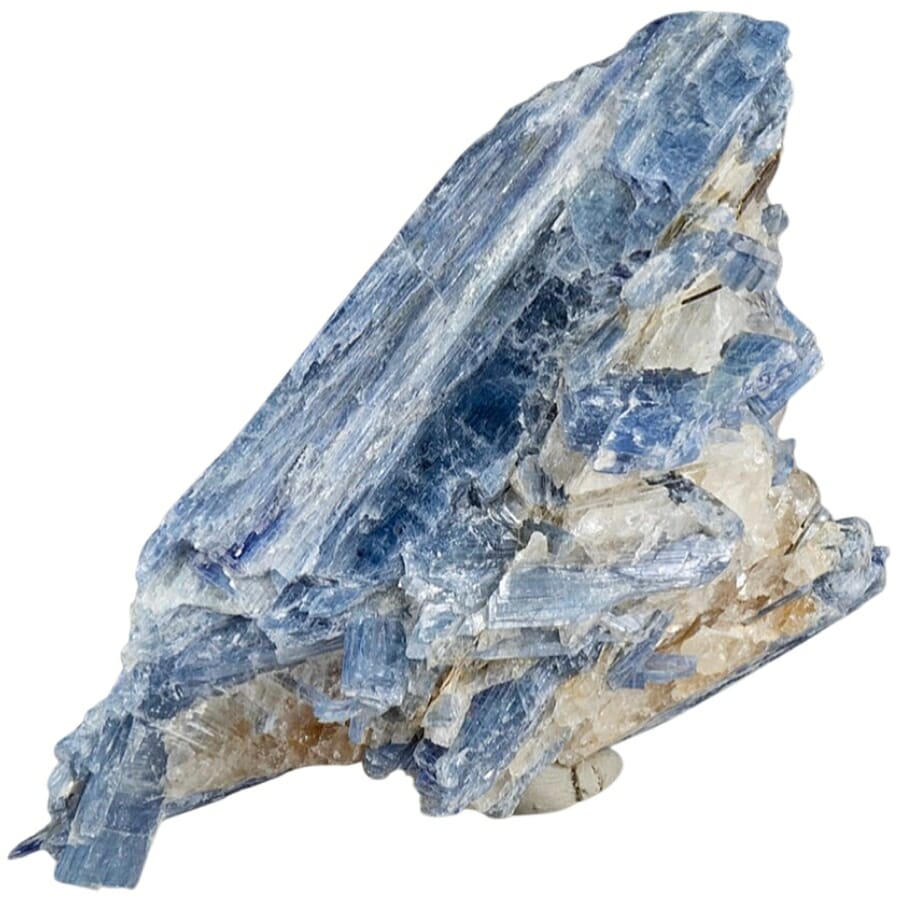
Kyanite is a blue, bladed crystal that can also be found in green, yellow, and even colorless forms. If you want to talk about a crystal that has some fantastic properties and a connection to Virginia, kyanite is the one.
It’s formed when heat and pressure combine to make something truly special. They form in long, thin blades that can look like tiny, shiny swords.
The blue color of kyanite can range from pale to deep. It’s often used in jewelry, but it doesn’t stop at just being pretty. It has a unique property called “anisotropism, which means it’s hard in one direction and soft in another.
You might be wondering why we said kyanite has a strong connection to Virginia. Well, our state is one of the best places in the whole world to find this crystal!
Where you can find Kyanite in Virginia
You can go to these places to find captivating kyanite specimens:
- O.W. Harris Mica Mine in Goochland County
- Rustburg area in Campbell County
- Difficult Run in Fairfax County
Pyrite
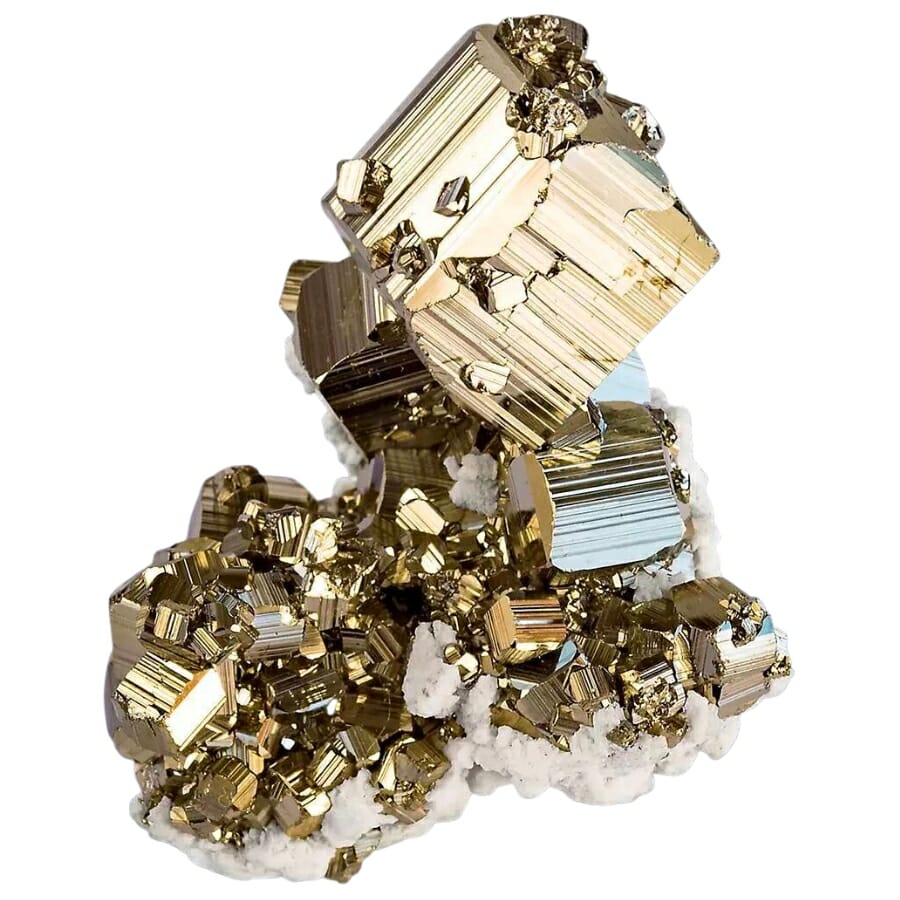
Often called “Fool’s Gold,” pyrite is way cooler than its nickname might suggest. You may have seen its shiny, golden appearance and thought it was the real deal. But it has its own incredible characteristics.
When iron and sulfur atoms come together in the right way, under the right conditions, they create this sparkly crystal. You’ll often find pyrite in rocks like shale or limestone, and it usually forms around the same time as these rocks.
Aside from its awesome appearance, pyrite’s value is also influenced by its practical uses. In the old days, people used it to start fires by striking it against steel.
Nowadays, pyrite is used in making sulfur compounds that we find in things like paper and ink. And believe it or not, it can even be found in some batteries!
Where you can find Pyrite in Virginia
Pyrite is pretty widespread in our state, and you can find them in these sites:
- Elk Creek area in Grayson County
- Copper mines of Lydia area in Greene County
- Lexington area in Rockbridge County
Chalcopyrite
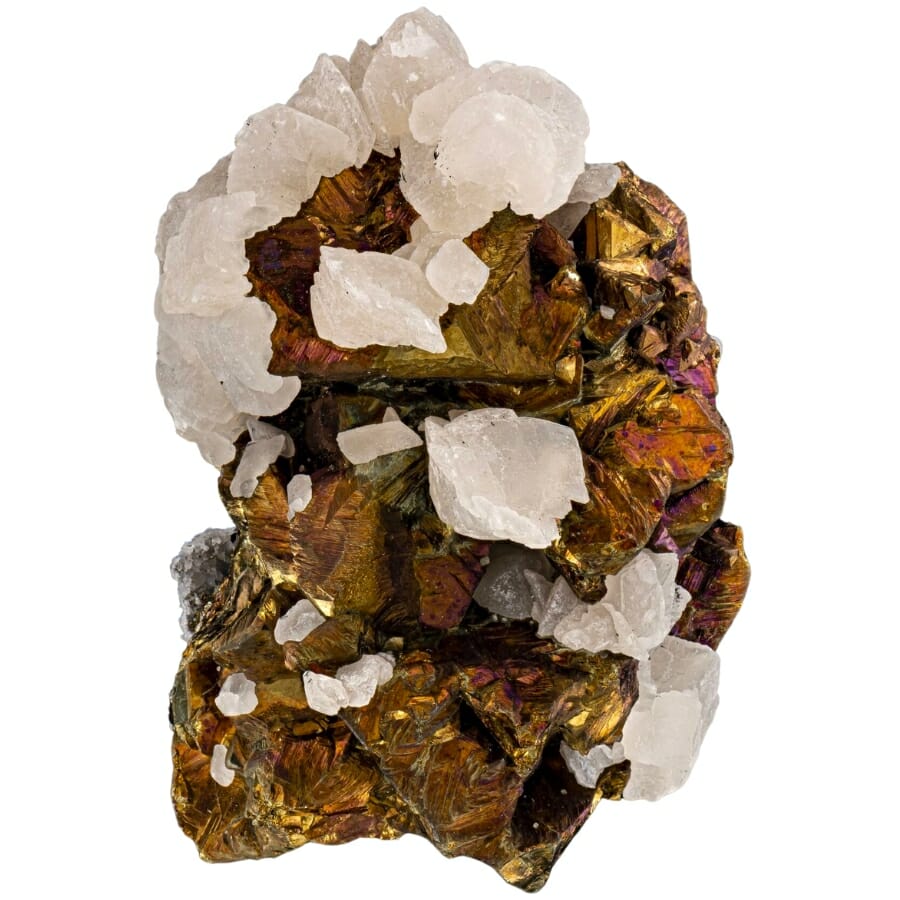
If you’re a fan of shiny finds, chalcopyrite will fascinate you. Imagine a blend of gold, green, purple, and more, all mixed together. It’s also often mistaken for gold like pyrite because of its color, but it’s much more colorful and vibrant.
Chalcopyrite is formed when copper, iron, and sulfur combine. Its crystals grow in cool shapes and often near other minerals like pyrite and quartz.
This crystal is one of the most important sources of copper in the world. Think of all the wires and pipes in your house— chalcopyrite helps make those! But that’s not all. It’s even used in research to develop solar energy.
Where you can find Chalcopyrite in Virginia
You can find chalcopyrite if you explore these sites:
- State Limestone Quarry in Appomattox County
- Hardware area iin Fluvanna County
- Mining dumps in Galax area, Carroll County
The Most Valuable Rocks and Minerals in Virginia
Virginia is not only loaded with common finds; our state is also blessed with rare rocks and minerals that will catch your attention once you lay eyes on them. Some of our favorite ones are below:
Greenstone
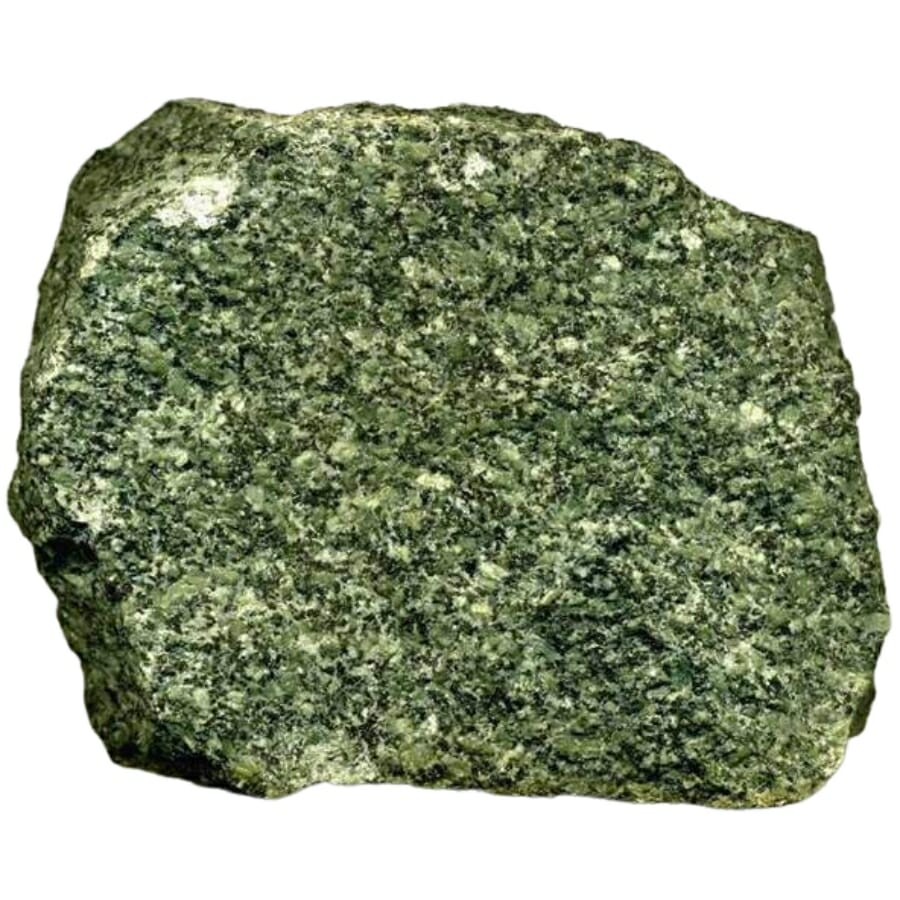
Greenstone is a special rock that’s pretty famous in our state, and for good reason. It has a beautiful green color, like the leaves on a tree in the spring.
Long, long ago, lava oozed out of volcanoes and then cooled down. This lava had unique minerals in it that turned green as they changed over time. This process is called “metamorphism,” and it turns the lava into this beautiful greenstone.
Builders and artists have used Virginia greenstone it to create statues, buildings, and even gravestones. It’s a way for them to add a touch of nature’s beauty to their work with a material that’s sturdy enough to last a lifetime.
Where you can find Greenstone in Virginia
You can find greenstone if you explore the Charlottesville area in Albemarle County and the area quarries and mines of Lynchburg in Campbell County.
Moonstone
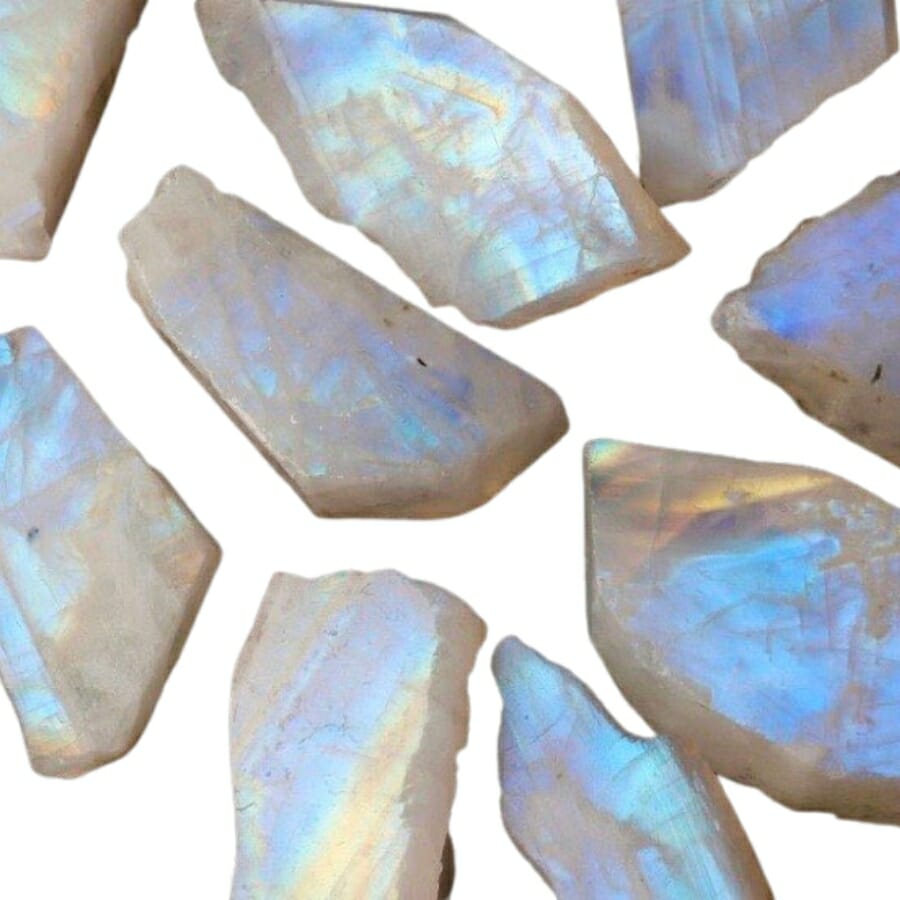
Moonstone is an ethereal-looking gem that people have loved for centuries. It has a soft, milky, moon-like appearance with a shimmering light inside. This special glow is called “adularescence,” and it makes the stone dance with colors like blue, silver, or rainbow.
Moonstone is made of two minerals: orthoclase and albite. They start off mixed together but then slowly separate into thin layers as they cool down. This layering creates that dreamy glow we see in this gem.
In ancient times, people thought moonstone could bring good luck or even make you fall in love. Today, people wear it as jewelry to feel calm and peaceful. It’s a favorite among artists and jewelry designers.
Moonstone’s value isn’t just in its beauty or its price tag. It’s in the way it connects us to the mysteries of the universe, the stories of the past, and the creativity of the human spirit.
Where you can find Moonstone in Virginia
To spot moonstone, you can visit these locations:
- H.T. Flippen Mica-Beryl Prospect in Amelia County
- Mitchell Mine and adjacent areas in Bedford County
- O.W. Harris Mica Mine in Goochland County
Staurolite
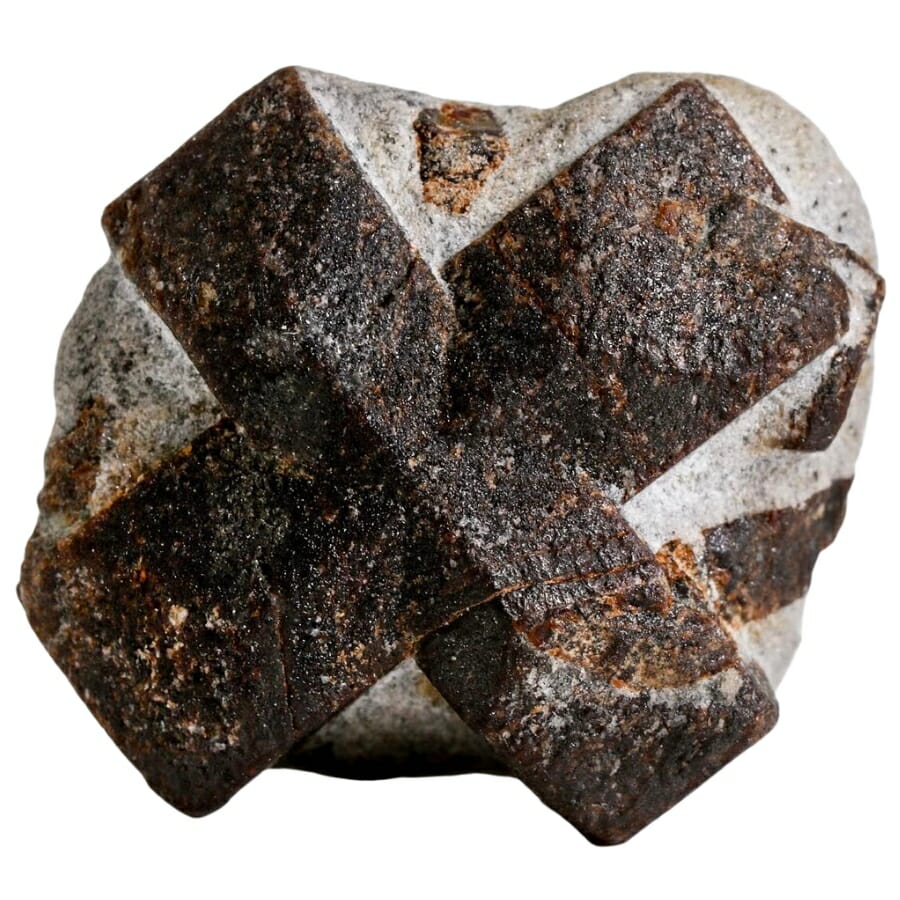
Staurolite is one of those rocks that make you stop and go, “Wow! How did that happen?” It’s like Mother Nature was playing with her art supplies and came up with something truly special.
It’s known for its cross-like shape, making people call it “fairy stone” or “fairy cross”. Staurolite is made from a mix of different minerals like aluminum, iron, and silica. When they get together under the right conditions, they form these crystals.
While its looks are unique and surely adds to its worth, staurolite is valued for many reasons. Some believe it brings good luck and protection, so they carry it around like a lucky charm. Others value it for its connection to nature. Geologists also see staurolite as a clue to understanding the past.
Where you can find Staurolite in Virginia
Staurolite is found in different sites in our state, including:
- Tower Hill in Buckingham County
- Road cut near the south bank of the Smith River in Henry County
- Old Womans Creek in Pittsylvania County
How to Identify The Rocks and Minerals You Find
Identifying rocks and minerals may be challenging, but there are simple, doable steps that doesn’t require much equipment or complicated procedures. If you want to identify a specimen, you may do the following:
Examine its color
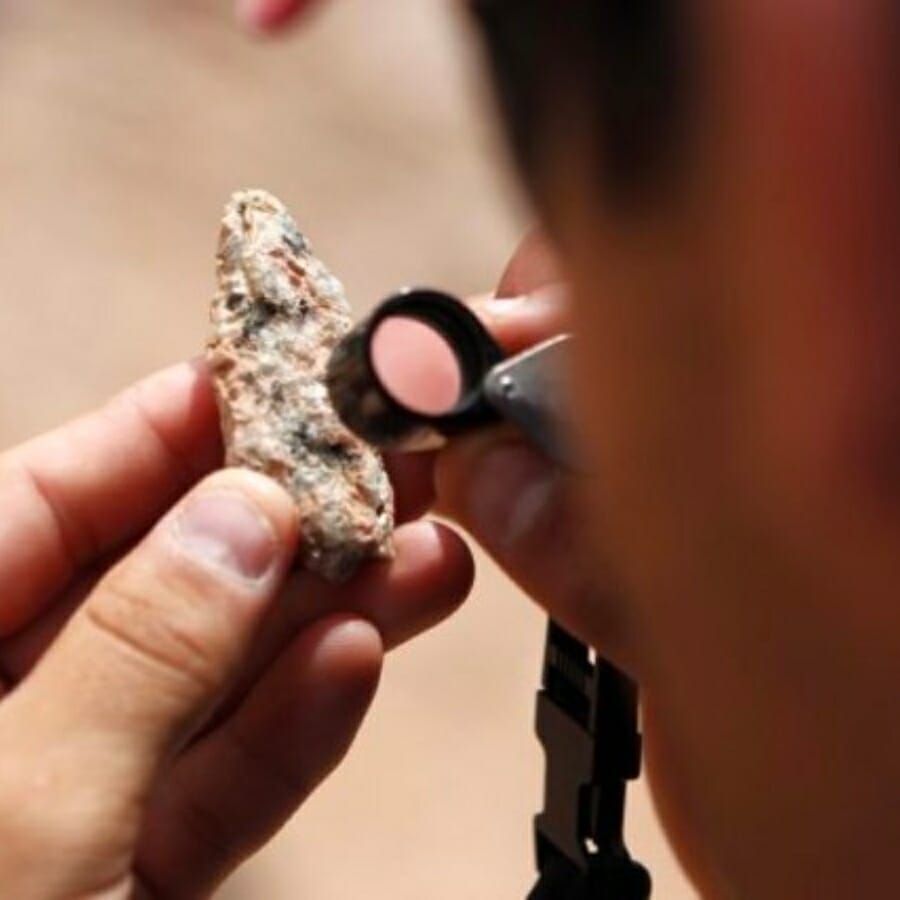
One of the first things people notice about rocks and minerals is their color. It’s like the first hello from a rock! Though it might not always be the most accurate way to identify a specimen, it’s a good starting point.
Some rocks and minerals have distinct colors, like malachite’s green or azurite’s blue. Just keep in mind that impurities can sometimes change a rock’s color, so don’t rely solely on this.
Check for luster
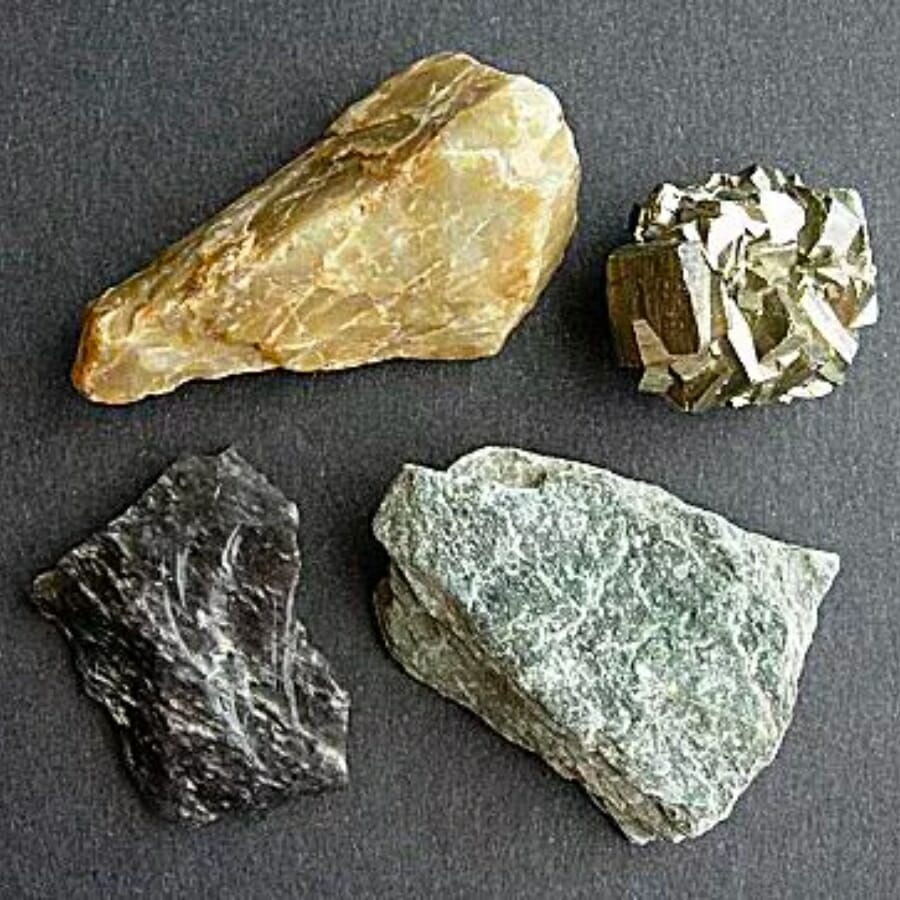
Shine bright like a diamond, or maybe not! Luster tells you how a mineral reflects light.
Is it shiny like metal, or more like glass? Maybe it’s dull and doesn’t shine at all. Looking at how a rock shines in the light can tell you more about what’s inside.
Observe its shape and crystal structure
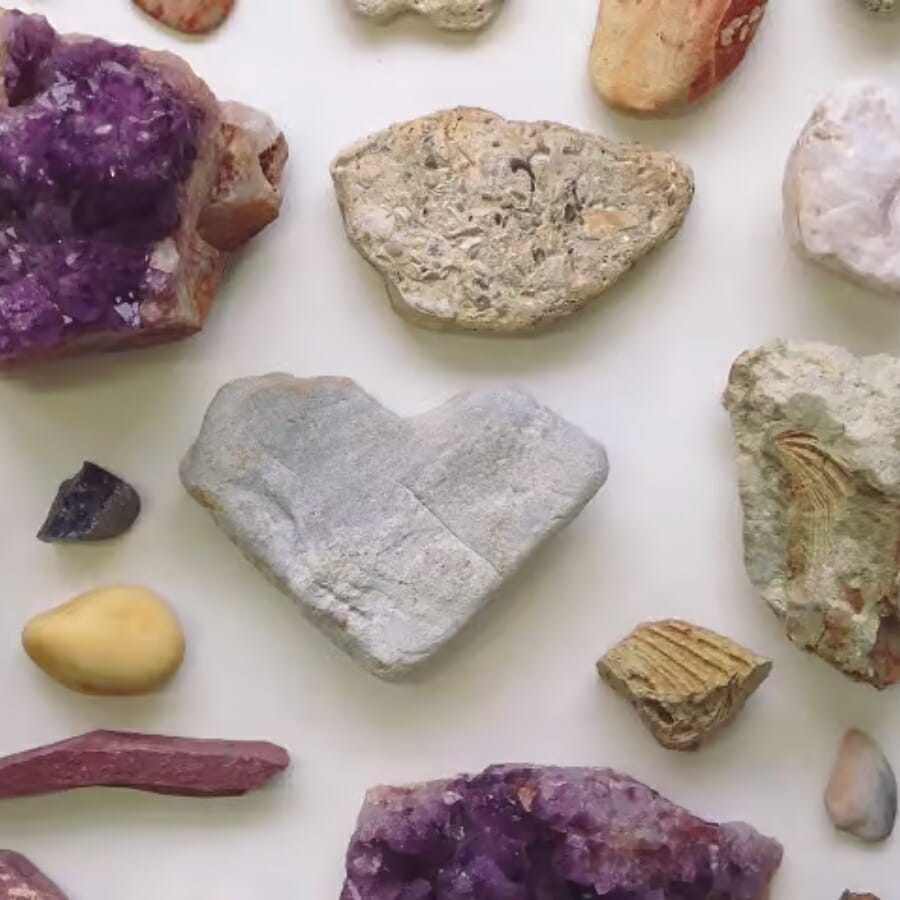
Some rocks and minerals have distinct shapes and crystal structures. If you find a specimen that has flat faces and sharp edges, it might be showing its crystal form.
Rocks and minerals like to grow in certain shapes, and recognizing these can be a fun way to identify them.
Do a streak test
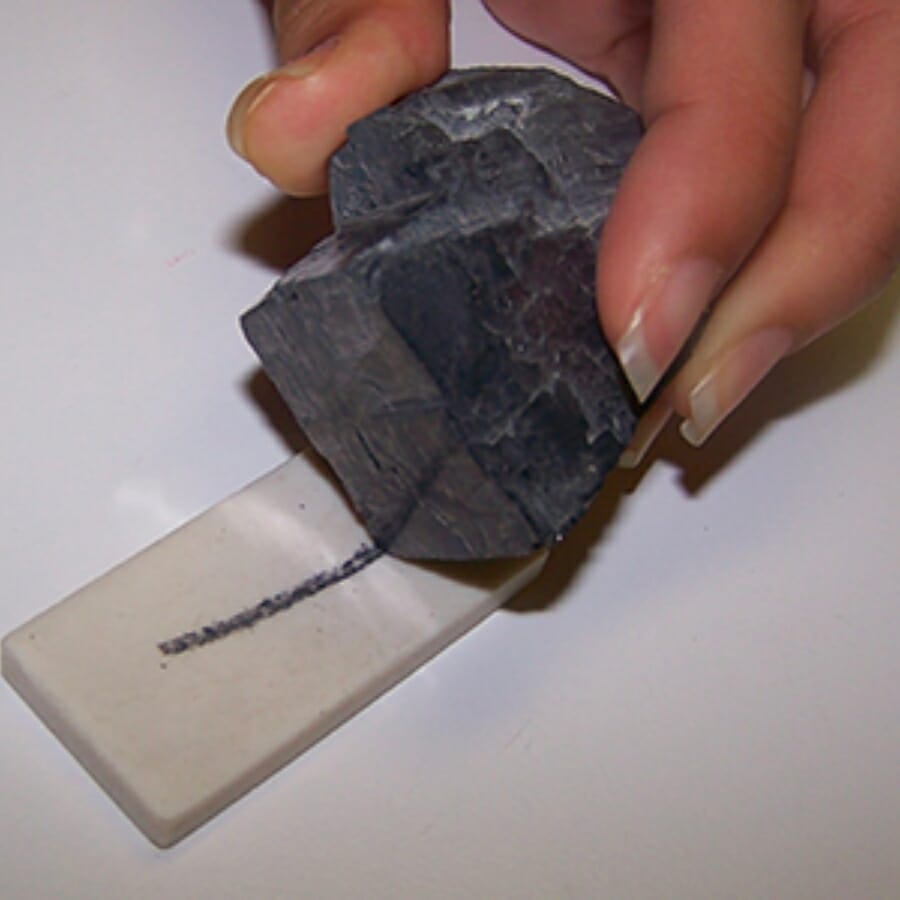
Ever rubbed a rock on something and seen a colored line left behind? That’s what the streak test is all about!
You can take your specimen and rub it on a piece of unglazed porcelain like the back of a tile. The color of the streak can give a clue to what you have. It’s like a rock leaving its signature!
Compare its hardness
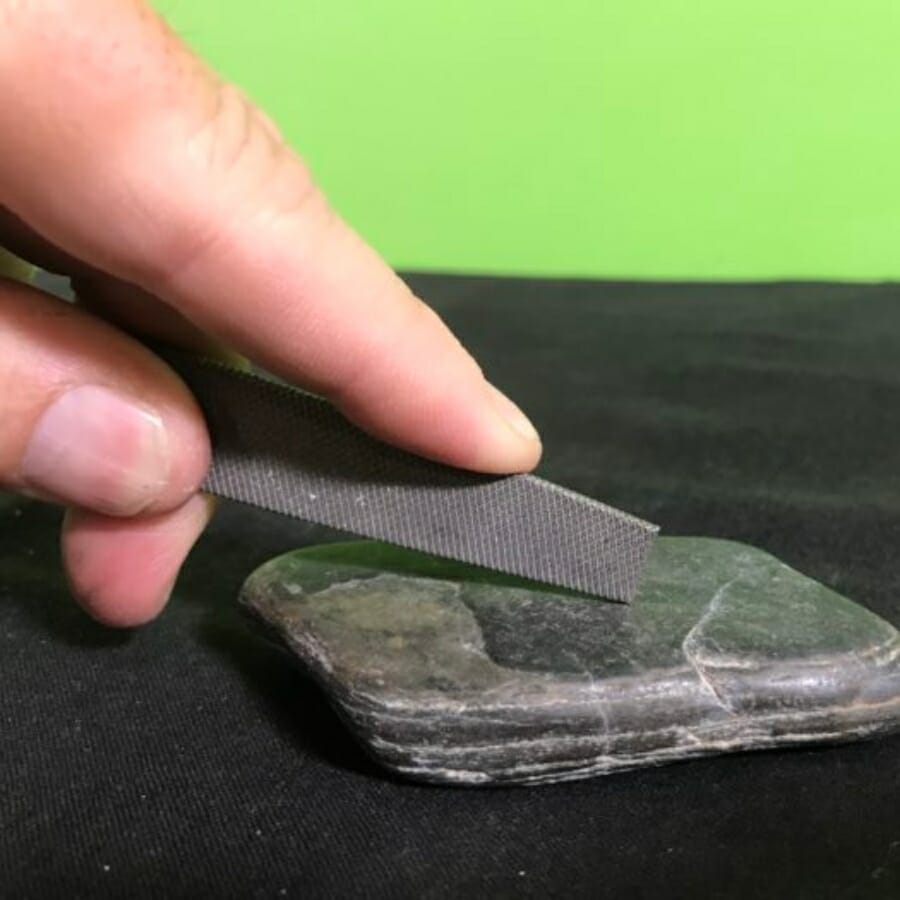
Some rocks are tough, and some are soft. The Mohs Hardness Scale can help you figure out where a specimen stands.
You can test how hard your find is by scratching it with common objects like a fingernail or a steel nail. If it scratches easily, it’s on the softer side. If it’s tough to scratch, it’s harder.

